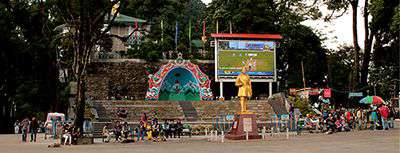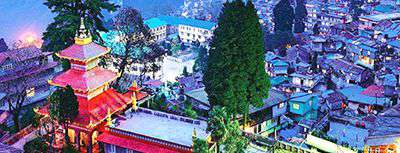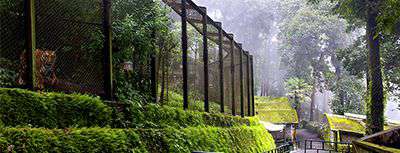Places With Night Stay
Mirik
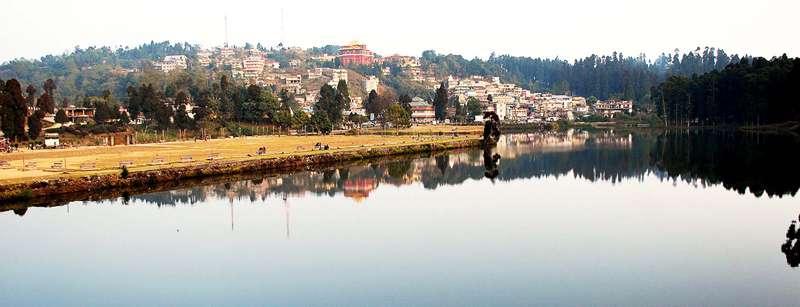
At an altitude of 5000ft a sleepy picturesque village famous for its orange orchard is Mirik, located 49km away from Darjeeling. Mirik is surrounded by lush tea gardens, orange orchards, cardamom plantations and forests of tall, dark Japanese cedars which are quite alluring sight for any nature lover. Sumendu lake or as locals calls it Mirik Jhill is situated at the heart of Mirik. The serene water body is surrounded by garden on one side and pine trees on the other connected by an arch footbridge called Rainbow Bridge. The depth of water varies from 3 feet to 25 feet. There are pony rides, boating, fish feeding and picnics to enjoy and you can ride a paddle boat as well for a breezy spin around the lake. On a clear day the lake reflects the image of the Mt Kanchenjunga which just adds a whole new level in the lake’s beauty. There are many places of tourist interest in Mirik like Tingling view point, Sun rise view point and Rai Daph the famous picnic spot for both local and tourist. Mirik, a beautiful mountain retreat in the outskirts of Darjeeling is a paradise for all the people who long for unhurried pace of life.
Manebhanjan
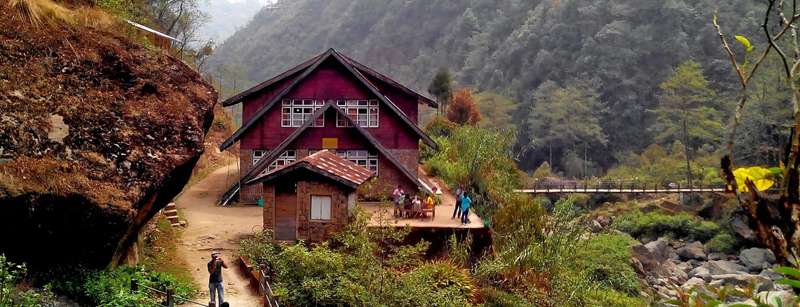
26 km from Darjeeling at an altitude of 6325 ft Manebhanjan is a small sleepy village situated on the fringe of Indo-Nepal border. In Nepali Mane means Buddhist Stupas and Bhanjayang means junction together it means junction of Stupas. The popular Sandakphu & Singalila Trek begins from here. Many refer Manebhanjan as the gateway to Singalila. Probably Manebhanjan is the only place where you will witness the Land Rovers used in British era is still being used. This four wheel drive vehicles are the perfect for climbing the rock filled rugged terrain towards Sandakphu. Though there are just a couple of them remaining. The 4 hour ride to Sandakphu can be quite jump. Trekkers set to take the Sandakphu trail the highest peak of West Bengal, from India side normally use this place as their base camp. The trek, which starts, from Manebhanjan, is a spectacular birding trail where following birds Blood Pheasant, Rufous-bellied Woodpecker, Himalayan Griffon, Steppe Eagle, Golden Eagle, Spotted Nutcracker, Plain-backed Thrush, Rufous-breasted Bush Robin, Blue-capped Redstart and many more can be seen.
Dhotrey

Dhotrey also spells Dhotre situated at an altitude of 8,340 ft is a scenically blessed sleepy settlement within the buffer zone of Singalila National Park. 11 km from Darjeeling this place is a small mountain village with less than 70 small huts. The ambience of Dhotrey will compel one to fall in love with this place. Electricity is not provided here since this village is located within the national park buffer zone. An interesting 7 km forest trail can be taken towards Tonglu amidst Singalila National Park. These magnificent trails will sooth one’s mind with its scenic beauty and chirping songs of birds. Breathtaking view of majestic Kanchenjungha is one of the best features of Dhotrey. Another point of interest is the local monastery of Kagyu sect of Tibetan Buddhism. Best time to visit Dhotrey is from October to December with clear sky for mesmerising sight of Kanchenjungha. To witness the blossoms of Rhododendron, Magnolia and Orchids the best time to visit Dhotrey is March and April. Many trekkers prefer to start trekking from here towards Sandakphu.
Tonglu

Tonglu a small settlement on the way to Sandakphu from Manebhanjan in Darjeeling district is situated at an altitude of 10,130 ft. Many trekkers prefers to take their night halt while trekking towards Sandakphu for the majestic view it offers. Earlier during 17th century it was known as Mt. Tonglo which is actually a peak of Singalila ridge. One can come by a vehicle up to Meghma from there take an hour trek to cover 2 km distance to reach Tonglu. The last stretch of the trekking trail is quite steep that is the reason the uphill climb takes unusually extra time to walk. Though the next point Tumling 2 km away from Tonglu is a quick descend. April-May is the ideal season as one can spot Rhododendrons welcoming on the way. The view of Mt. Kanchenjunga and other snow-capped mountain of Eastern Himalayas is really spectacular from here. Just look downwards and you may trace Koshi River on a clear day. The landscape will heal your pain to reach here for sure. From here during night lights of Darjeeling and Kurseong is visible.
Tumling

Tumling is your perfect option if you don’t want to stay at night at Tonglu or else wants to avoid steep trekking. Tumling is small sleepy hamlet on the way to Sandakphu at an altitude of 9,600ft. From Manebhanjan four wheel drive vehicles old land-rovers will take almost 2 hours to cover 13 km. At the centre of this hamlet the grand view point is situated. You can have the breathtaking panoramic view of snow-capped landscape including Mt. Kanchenjunga and the peak of Sandakphu. 1 km away is the entry point of Singalila National Park. Tumling is basically part of Nepal though there is no restriction to visit this place. There are no clear demarcations of the border are present. The fluttering of Buddhist prayer flags adds another dimension in the ambience. There is a common misconception with prayer flags among common people that is these flags carry prayer to gods. According to the belief of Tibetan Buddhism the prayers and the mantras scripted on the flag will be blown by the wind thus spread the good will and tenderness into all permeating space. This prayer flags are use to promote wisdom, compassion, peace and strength.
Sandakphu
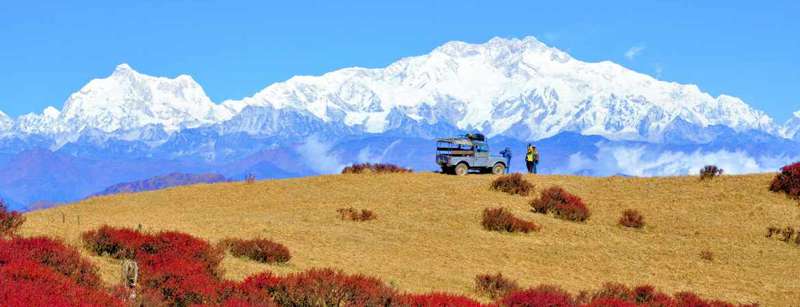
Trekker’s dreamland Sandakphu is situated at an altitude of 11,929 ft and it is 32 km from Manebhanjan. Sandakphu is the highest peak of West Bengal situated on the highest point of the Singalila Ridge in Darjeeling district. The word Sandakphu means ‘Height of poisonous plant’. The poisonous plant that grows on the hilltop is the reason for such name. Sandakphu is trekker’s dreamland because of its view; from here one can see the 4 out of first 5 highest mountain peaks of the world. The peaks are Mt. Everest (29,028 ft highest peak), Mt. Kanchenjunga (28, 169 ft 3rd highest peak), Mt. Lhotse (27,940ft 4th highest peak) and Mt Makalu (27,825 ft 5th highest peak). While on the way to Sandakphu last 18 km trek is through Singalila national park through the forests of flowering rhododendrons of numerous types, giant magnolias, spruce and wide range of amazing orchids. There are over 600 varieties of orchids in this area, the largest concentration in any single geographical area in the world. For flower lover April and May is the right season for Sandakphu trekking. Apart from trekking one can reach Sandakphu by land rover from Manebhanjan. For its awesome journey trekking paradise Sandakphu is favoured by Nature lovers, Flower lovers, Wildlife lovers, Mountain lovers as well as photographers.
Phalut
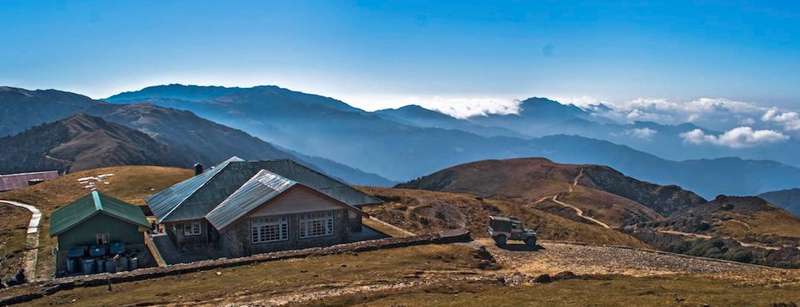
You can take out a person out of mountain but you can’t take mountain out from that person’s heart. This is a popular saying among the mountain dwellers. So do believe travellers and trekkers from plains who love mountains. The travellers who want to take the thrill of trekking through the rugged terrain while testing and pushing one’s limits then trekking towards Phalut is a perfect choice. Phalut is one of the highest peaks of Singalila range and located in Darjeeling district at an altitude of 11,811 ft is the second highest point in Singalila ridge after Sandakphu (11,929 ft). It is said that trekking to Himalayas is incomplete without Sandakphu Phalut trek. Phalut, a paradise for the lovers of trekking, lies on one of the loftiest eminences of the Singalila range. Situated around 80 km from Darjeeling the unique location of Phalut lets the travellers enjoy the journey with an amazing trail boosting with the vibrant wildlife. During spring season the route is more beautified with the blooming sight of rhododendrons. Phalut offers the nearest view of snow ranges obtainable in Darjeeling district. Nestling amidst charming mountain scenery with magnificent view of snow peaks and glaciers, Phalut is very favoured destination for the trekkers. Few trekkers' hut and bungalows are available here providing accommodation for the trekkers. Phalut is located on the Indo-Nepal border due to which the trail leading towards Phalut swings between India and Nepal border area. The high altitude of Phalut resulted in Phalut being a windy region so the tourist should be prepared for sudden changes of weather accompanied by short, heavy downpours. Manebhanjan is a quaint transit town famous among the tourist for being the gateway towards Singalila Range. Trekkers love to use Manebhanjan as their base camp while their trek to Sandakphu and Phalut. Manebhanjan is the only place in the Darjeeling District where one can see a vast collection of vintage yet trusted land rovers used during British era. The motor able roads towards Phalut are not well paved rather more of a clear path filled with gravels. Himalayas has been blessed by some of the most rare and exquisite beauty of Mother Nature which has ensnared the heart of travelers from around the globe.
Sirikhola or Srikhola

Amidst Magnolia, Chestnuts, Oaks, Birches, Pines and Rhododendrons is another breathtaking destination in Darjeeling district Sirikhola. Beside Sirikhola River this sleepy little settlement is situated on the foothills of Singalila National Park. Sirikhola comes under the return trek route from Sandakphu to Manebhanjan via Gurdum and Phalut to Manebhanjan via Gorkey and Rammam. Sirikhola can be approached from Darjeeling by car as well. Enjoying the river amidst nature, visiting the hanging wooden bridge or else spending time by fishing Trouts could be some activities in Sirikhola. Spotting birds like sparrows or blue magpie is also an option. Visit the village’s monastery and temple. Since this place located at the periphery of Singalila national park short trek through the woods can give a chance to spot Red Panda, Himalayan Black Bear or Barking Deer. Take a walk amidst Oaks, Birches and Pines filling your ears with the natural tune of birds to get freshen up. During March and April this place becomes valley of flowers with exhibiting flowers like Rhododendrons, Magnolia and Orchids. Walk through the A short trip to the large variety Cardamom, Peas and Corn gardens will be very exciting. Travellers from abroad love visiting these gardens.
Sukhiapokhri and Jorpokhri

At an altitude of 7,400 ft, 19 km from Darjeeling on a hilltop near Lepchajagat Jorpokhri is situated. Jorpokhri is located 2 km above Sukhiapokhri and this 2 km is shrouded with virid thick woods consisting Camphor and Pine trees. A trek through this 2 km could be very interesting and thrilling. This is a part of Senchal wildlife sanctuary. Since the word ‘Jorpokhri’ means twin ponds or twin lakes and there are twin lakes situated on the hilltop so name of the place become Jorpokhri. The boundaries of lakes are concreted and decorated with seats while on the water onlookers might spot swimming white swans. In the middle of the lake a model of huge snake is erected along with a fountain. From the northern side of lake the spectacular view of snow-capped Himalayas including Mt. Kanchenjunga (28,169 ft) will surely leave you speechless. Especially during the sun rise the White Mountain range shows it magic. Since Jorpokhri is situated on the ridgeline between Rangeet River and Balason river valley the unpredicted clouds steals the majestic sights of snow-capped mountain without any forewarning. From the other side the landscape of Darjeeling will left you speechless. A short trek to Sukhiapokhri amidst green is worth give a try. Literally from Sukhiapokhri the way to Sandakphu starts. Tourist can stroll around the main road and the market area of Sukhiapokhri for a while. On a clear day majestic view of Mt. Kanchenjungha from Sukhiapokhri surely take out one’s breath.
Lepchajagat
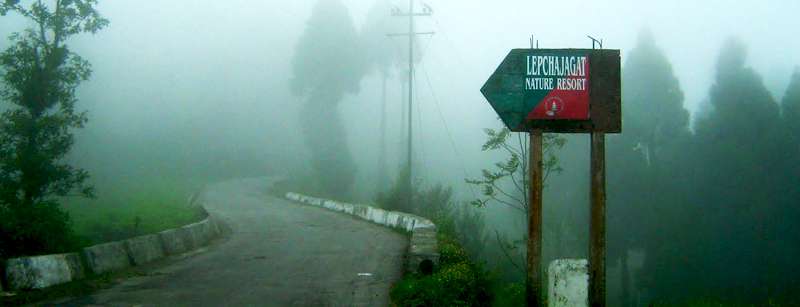
The word Lepchajagat means the world of the Lepcha. West Bengal Forest development Corporation (WBFDC) has taken over this part of North Bengal which was actually belongs to the Lepcha tribes and now is a reserved forest area. Situated at an altitude of 6,956 ft and at a distance of 19 km from Darjeeling Lepchajagat is a small village located in wilderness. With its own world Lepchajagat is an ideal destination for those tourists visiting Darjeeling but planning to take a diversion from the hustle and bustle of the Darjeeling town. With bounty of natural beauty Lepchajagat is covered by wild forests of rhododendron, pine and oak. On the north-eastern side of Lepchajagat Mount Kanchenjunga with its surrounding peaks stands with its full might. Particularly during early morning the sun casts a rich, golden glow on the five peaks of the mountain range makes for a truly magical experience. This is an ideal place for nature lovers to stay in an offbeat place with a blend of nature and peace. Birdwatchers will be thrilled with the amazing variety of birds that inhabit Lepchajagat apart from its stunning greenery and mountain views. As nature is full blown in Lepchajagat, the main activity here can be roaming in the nature with the company of wild forest, numerous birds, sea of mountains and silver glazing Kanchenjunga. Lepchajagat offers good views of sunrise and sunset. Together with the beauty of colourful blossoms in full bloom and the verdant greenery of coniferous trees, the forest of Lepchajagat is truly a picture perfect destination. Lepchajagat offers ample opportunities for those interested in bird watching, trekking or just plain walking. Trekking to Himal Falls or Hawaa Ghar (Hawaa means Airy and Ghar is room) is an exciting option for the adventure seeker.
Chatakpur

At an altitude of 7,887 ft amidst the lush green alpine forest of Senchal Wildlife Sanctuary is a serene eco friendly village named Chatakpur. It is situated above a quaint hamlet name Sonada at a distance of 26 km from Darjeeling. Forest department’s initiative to stop the timber trafficking the possibility of eco tourism as alternate way of source of income pave the way of Chatakpur to grow as a tourism destination. With its mesmerising natural beauty quickly Chatakpur is making place as tourism destination in the heart of nature lovers. The watch tower situated at 10 minutes walking distance from the forest cottages of Chatakpur offers the most breathtaking sunrise over the snow clad Himalayan mountain range. Offering the impeccable vista of Kanchenjunga, Chatakpur is a hidden jewel of Darjeeling tourism. Chatakpur is full of astounding forest trails one of which leads towards Pokhari. Pokhari or Pond is located at 10 minutes walking distance. Pokhari acts as a host for numerous Himalayan birds which has made Chatakpur a favoured birding spot for avid bird watchers. Far from the madding crowd, Chatakpur with its vivid greenery and pictorial trekking routes has become the sojourn for all the travellers who want to find solitude amidst the nature.
Sitong

A new found jewel of North Bengal is Sitong surrounded by luxuriant orange orchard. Sitong also known as the Orange Village is a quaint Lepcha Hamlet. At an altitude of 4000 ft and tucked amidst the alpine forest Sitong is an offbeat destination near Darjeeling. Sitong with its serene ambiance and calm weather has become an ideal destination to escape the scorching summer heat of plains. Sitong with its mouth watering oranges and surreal view of Mt Kanchenjunga has enthralled the mind of many. The places can be visited from Sitong are Dilaram, Kurseong, Latpanchar, Mongpoo and Mahananda Wildlife Sanctuary. Visitors can stroll around the village and go to the Sitong view point located near the church to get the panoramic view of orange orchards. In Sitong church guest house has been renovated with modern amenities for accommodations of travellers, apart from this few home stays are also available in nearby Toryuk village.
Latpanchar
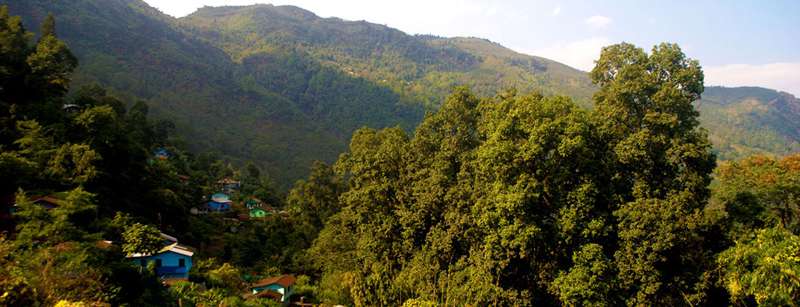
The highest point of Mahananda wildlife sanctuary Latpanchar is situated at an altitude of 4200 ft is somehow not so popular reason. Though blessed with nature this little hamlet offers stunning views of Himalayas including Kanchenjungha. There are very fair chances to spot some wildlife as this place is situated within the sanctuary area. From New Jalpaiguri the distance of Latpanchar is only 44 km and from Darjeeling the distance is around 57 km. Since this place is not so popular so far travellers will find solace even in heavily packed season time’s Darjeeling. To explore the forest travellers must take a guide from the village. While your exploration you might come across with deer, barking deer, wild boars, and sometimes even leopards and elephants. A visit to Ahal Dnara 5 km from here is must. From the top traveller will find mesmerising view of Kanchenjungha, Teesta river and the valley with full of cinchona plantation. The experience of sun set from this place will leave you enthralled. From Ahal Dnara Visiting Namthing lake will be a nice idea. The journey through cinchona and pine will add spice to the journey. During monsoon a visit to Namthing Lake will give traveller a fair chance to spot Himalayan Salamander (a lizard like creature) or Himalayan Newt. Sarsari Dnara is another view point located near Latpanchar to experience Kanchenjunga’s majestic beauty.
Siliguri

The Gateway to the North East India Siliguri is a bustling city of West Bengal, India. The distance between Darjeeling and Siliguri is 62 km via Matigara. The second largest city of North East Region, Siliguri is located on the foothills of Eastern Himalayas along the bank of Mahananda River. The connectivity to pictorial destinations like Bhutan, Darjeeling, Nepal and Sikkim make Siliguri famous amongst the travellers along with its tea gardens and temples. Bagdogra Airport is located at a distance of 12 km from Siliguri. There are many places to visit around Siliguri which has hyped the interest of travellers. Summers are hot and humid making winter season the best time to visit Siliguri. Siliguri is the melting pot of diverse culture where travellers can see people of different community living in peace and harmony. Being the hotspot of diverse culture, travellers can taste variant cuisine of Northeast region while travelling to Siliguri. Venture upon the scenic Himalayan valleys and less trodden land of North Bengal from Siliguri while being awe-stricken by the alluring charisma of this vibrant city.
Sukna
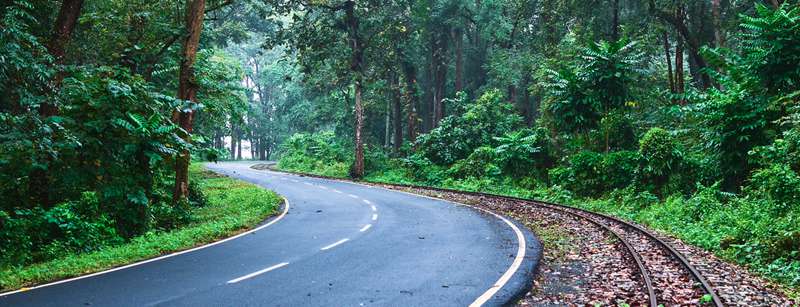
67 km from Darjeeling and merely 15 minutes drive from Siliguri Sukna is situated at an elevation of 410 ft, three sides surrounded by lush green forest of Terai a part of Mahananda wildlife sanctuary. Shrouded amidst nature this little town has three distinctive treasures like the Forest Department campus, the Sukna Railway station of DHR and the Sukna Cantonment. In the forest of Sukna traveller can spot herd of migratory elephants or leopards can also be found. Mahananda River is flowing on the fringe of Sukna forest is an alluring place for visitors especially during winter. People from almost all nearby places come here in winter for picnic. There are few more places of tourist interest in and around Sukna such as Umrao Singh Boat Club, Tea gardens and Madhuban Park. There are a few small hotels or resorts in the way between Siliguri and Sukna. Anyone can stay at an affordable rate on his or her way to reach at Sukna. In Siliguri, there are also many luxurious hotels. Apart from these hotels, one can stay at the forest bungalow at Sukna.
Lamahata
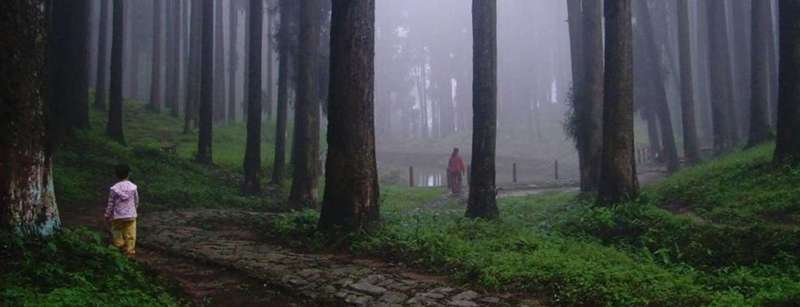
At an altitude of 6,800 ft and at a distance of 23 km from Darjeeling Lamahata is situated amidst virid pine woods offering majestic view of the world’s third highest mountain peak Mt. Kanchenjungha. A 500 years old Buddhist monastery is situated at a 20 minutes walking distance from here. Lamahata developed as a tourism destination in the year 2012 is manicured with a beautiful garden and park. A couple of small lakes are there at the top of Lamahata amidst pines. To reach there one has to take a small trek upwards. The mini trek route is well maintained with occasional stone steps for the comfort of trekkers. The view of the lake surely leaves one mesmerised. Just above the park a watch tower is situated offering panoramic view of surroundings along with the wide Himalayan range. To experience the tranquillity of Lamahata spend a night over here in a home stay. Or else on your way to Kalimpong from Darjeeling or vice versa you can spend a couple of hours here to feel the nature at its best. Lamahata is place to spend time in solace far from the urban cacophony.
Mongpu
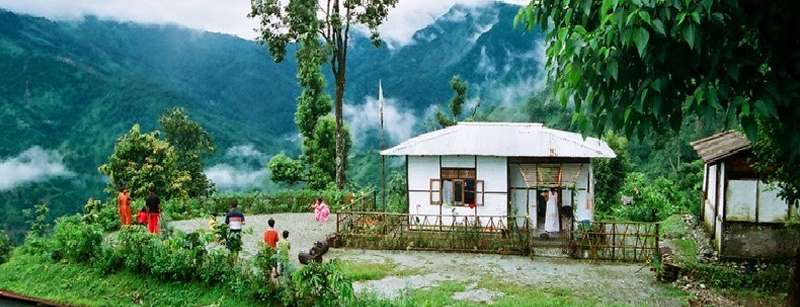
At an altitude of 3,700 ft from Darjeeling towards Takdah cantonment via Ghum at a distance of around 30 km lays the small old hamlet Mongpu. Mongpu is also spelt Mongpoo. Mongpu is famous for the production of quinine a drug used for Malaria although the modern day artificial quinine caused in lesser production but still it is the active source of income of this place. Cinchona was first introduced on Nilgiri hills and Annamalai hills in 1859 and after couple of years later it was introduced to this part of the country. In 1864 the Government Cinchona factory was established here. Just opposite to the factory you will find Rabindra Bhavan or Rabindranath Tagore Memorial Museum another must visit place of Mongpu. Here one can witness the bed and the Mahogany desk used by Tagore along with his original paintings and handwritten scripts of prose and verse. During 1938 to 1940 Tagore visited Mongpu 4 times. Mongpu is also known for schools. There are 12 schools in Mongpu. As there are no such views of famous snow-capped mountain from Mongpu one can visit this place for serenity and to enjoy solitude far from the madding crowd. There is a Dinchhen Sherap Choeling Gumba or Mongpu Monastery just above the market. Orchid centre just 7 km from market is a must visit place to witness the variety of Orchids of this area.
Takdah
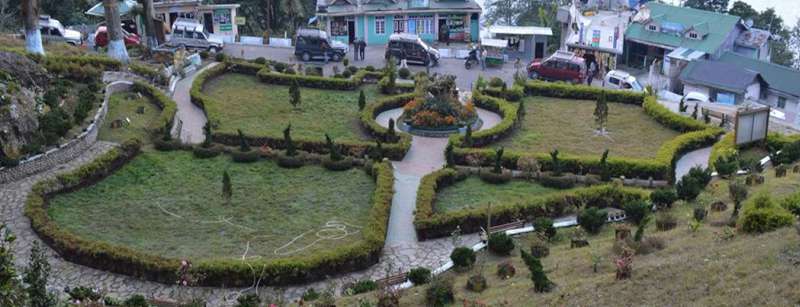
Takdah with panoramic scenic beauty, lush green tea gardens and blooming orchids is a perfect destination for sojourn for those wants to escape urban cacophony. Earlier this place was a British cantonment during pre-independence era. The old club situated 1 km away from the town amidst cedar trees is the witness of British cantonment. At an altitude of 4,000 ft and at a distance of 28 km from Darjeeling Takdah is situated. Takdah derived from a Lepcha word ‘Tukdah’ means mist or fog one can witness how appropriate is it while visiting Takdah. With gurgling fountains, singing of birds, fogy devious roads and trails through forest Takdah is ready to welcome traveller with its warmth. In and around Takdah one can witness few of the Darjeeling’s finest and spectacular tea gardens such as the most picturesque tea garden of the district is Rungli Rungliot tea garden, Gielle tea garden, Namring tea garden and Pubang tea garden. Just below the Pubang tea garden is a 100 years old cable stayed hanging bridge built in 1916. In Teesta valley tea garden there is a view point mentioned as Durpin Dnara by the locals is a must visit place. Here the panoramic top view of Teesta will take all your breath out for sure. From Rambhi to Sevoke the entire course of river Teesta for this stretch can be seen. Once Asia’s best Orchid Centre is situated in Takdah though during the movements in hills it was neglected for over decades but now once again initiative has been taken to revive it. Dechen Pema Choeling monastery is not that old, built in 1985, but worth to pay a visit. The view of the rolling tea gardens from here is mesmerising.
Tinchuley
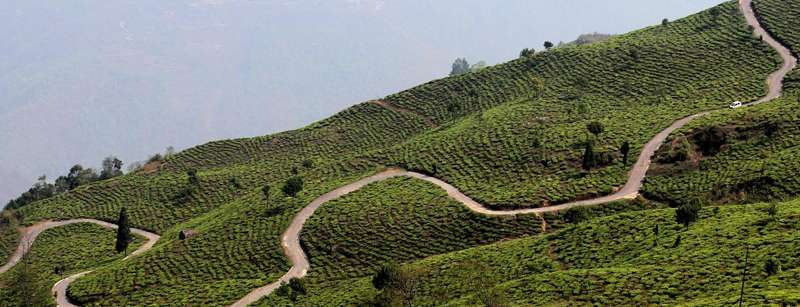
In India’s history of home stay concept Tinchuley has cemented its name forever. This is the place where first ever home stay was started in India in the year 1996 with 3 home stays. Tinchuley is a small sleepy village situated at an altitude of 5800 ft just 20 km from Darjeeling. The name Tinchuley derives from Tin Chuleys or Chulas that means three (tin) ovens (chulas) and such name to the village has been given because of the three prominent hill tops that surround the place and which from far look like ovens or chulas. This eco friendly destination with tea Gardens, Orange Orchard, and majestic view of Mt. Kanchenjunga makes it the most promising eco village and one of the key destinations. Just one km from Tinchuley village is a pine forest named ‘Mayadhari Royak’. In Nepalese Maya means Love and Dhari stand for ‘With’. According to a legend a Nepalese queen used to love this forest very much. Name of the forest is Royak after a forest village with same name. A walk through this pine forest will be sensational. Even travellers can trek to Lamahata through this forest. From the foothills of pines the view of Himalayan snow-capped range is breathtaking. Don’t forget to visit the only monastery of Tinchuley runs by the Ningma sect of Tibetan Buddhism. From Tinchuley one can visit Takdah, Takdah monastery, Takdah orchid centre, Rungli Rungliot tea garden and many more nearby places.
Chhota Mangwa
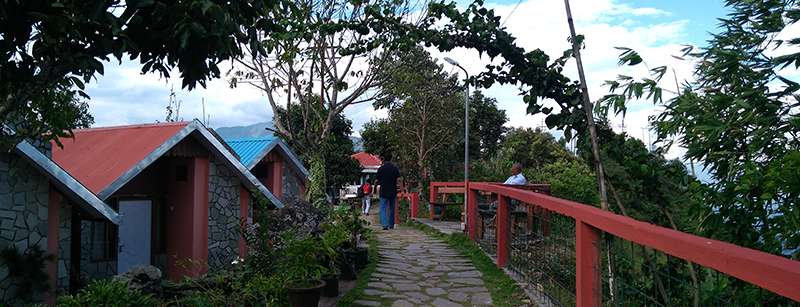
A sleepy little hilly settlement Chhota Mangwa is situated on the ridge of Mangwa hill is only 35 km from Darjeeling. Blessed with natures gift Chhota Mangwa is awaiting travellers from all over the world to show its magical beauty. The serene tranquil village offers magnificent view of Kanchenjungha and the meandering river Teesta from the top of the hill. On a clear day the statue of Lord Shiva at Chardham, Namchi is clearly visible from this place. From Darjeeling it will take around one and half hours to reach this place. In Lepcha language Mangwa means ‘Finger millet’ which was happened to be the main corps of this place. This new destination is gaining popularity due to its jaw dropping views. A traveller who wants to take break from hectic urban life for a day or two Chhota Mangwa is awaiting their visit. Traveller can take a trek down to visit nearby Taquleen monastery and also take a walk around the orange orchards and amidst forest to soothe your urban tiredness. Tinchuley and Takdah are located nearby a visit to both the places will be a good idea along with visiting one of the most picturesque tea garden of the district Rungli Rungliot. In every aspect Chhota Mangwa is a destination to rejuvenate a tired soul.

Tucked on the Mangwa hill relatively at lower altitude is a sleepy village Bara Mangwa. One of the major attractions of this place is terraced farming and orange orchards. Traveller can visit such farms to witness with bewilderment the varieties of corps are harvested here. This is a must visit place for the botany students and for them who have interests in Botany. A virgin tourists eco friendly destination with tea Gardens, Orange Orchard and Teesta River making it the most promising and beautiful eco tourist destination in Darjeeling. Exclusive remote retreats, with panoramic Himalayan views that will make one’s soul soar. Bara Mangwa is a perfect place for adventure seekers and nature lovers. The places can be visited from Bara Mangwa are Chhota Mangwa, Tinchuley, Takdah, Peshoke and Lopchu tea garden, Teesta and Rangit rivers meeting point and Mongpu. Adventure seekers can take few short trekking trails from here. Bara Mangwa is just 40 km from Darjeeling.
Kalimpong
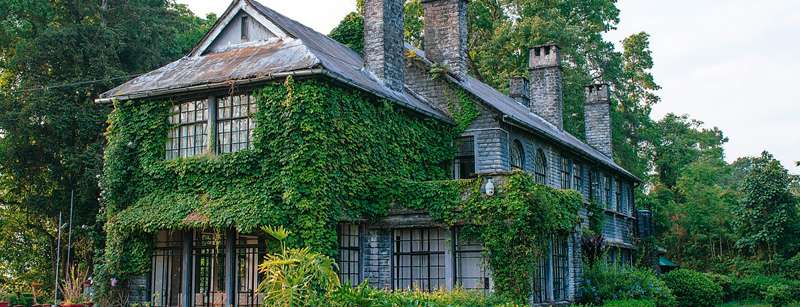
Kalimpong situated at the proximity of the old silk route at an elevation of 4079 ft is approximately 50 km from Darjeeling. Kalimpong now a district capital of Kalimpong district of West Bengal used be under Darjeeling district few days back. Kalimpong is best known for its breathtaking view and rich history. The first thing a traveller will notice after reaching Kalimpong is the churches and the monasteries sprawled around the small quite town. There are many places to visit in and around Kalimpong like Tharpa Choeling Gompa (monastery), Thongsa Gompa and Zong Dokh Palri Fo-Brang Gompa. Apart from these three monasteries Nursery is one of the highlighting features of Kalimpong. 80% of the total Gladioli production of India is produces here making Kalimpong an important flower producing hub. Pine view Cactus Nursery has a great collection of cactus and ornamental plants is a must visit destination of Kalimpong. Just 5 km from the town centre is a view point known as Durpin Dnara. The local word Durpin is synonymous to binocular and Dnara means hill top. Together it means a hilltop from where you can see far away. The Zong Dokh Palri Fo-Brang Gompa is a Tibetan monastery commonly known as Durpin Monastery located on the Durpin Dnara. From the upper terrace of the monastery the magnificent views of Kalimpong town with the backdrop of Mt. Kanchenjunga, the valley and the plains, Teesta & Reang Rivers flowing down, and lovely tea estates of Peshoke area are visible. Another place of tourist interest is Mangal Dham a temple complex built in the memory of late Guruji Mangal Dasji and dedicated to Lord Krishna. Yet another main attraction of Kalimpong is Dr. Graham’s Home. This missionary school was set up by Dr. J A Graham in 1900 as an orphanage cum school for the destitute Anglo Indian children. It is located on the way to Deolo Hills and traveller can walk across to various parts of the school. Deolo is an 8-acre lush parkland with manicured flower gardens and several view points with breathtaking views of Kanchenjunga. There is one Hanuman Mandir (Temple) situated on the hill. Traveller can take a short hike towards the temple to witness mesmerising and breathtaking view of world’s 3rd highest peak Mt. Kanchenjunga (28,169 ft) in its full glory on a sunny day. Traveller can also get a clear view of the neighbouring state Sikkim and the surrounding landscapes of lava and Kafer hills.
Chibo
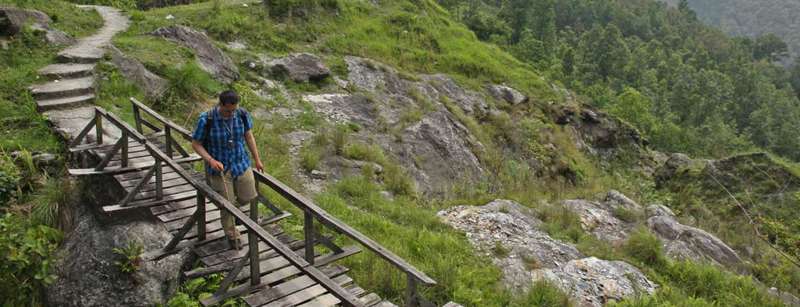
Chibo is a new found jewel of Kalimpong region hidden amidst the dense forest of pine trees. Nestled in the mountainous folds of Eastern Himalayas Chibo is a scenically blessed village. Untarnished by the modern society Chibo with its rustic style and serene ambiance has become a safe haven for the nature lovers and it is located at a distance of just 4 km from Kalimpong. With its mesmerizing view of Mt Kanchenjunga this quaint village caught the attention of travelers. Situated at an altitude of 4101 ft Chibo is blessed with blissful weather and endowed with rich flora and fauna. The proximity of Chibo with Kalimpong lets the visitors explore all the places located in and around Kalimpong like the Deolo Hill, Kalimpong Cactus nursery, Durpin Dnara view point and Pedong Monastery. Shrouded by dense virid forest Chibo offers some astounding short trek routes. The uphill trek through the dense pine trees takes the visitor to a viewpoint which offers the panoramic view of river Teesta meandering through the mountainous valley. Chibo is one of the vantage points in Kalimpong to witness the awe-inspiring sun rise and sun set over the snow capped Mt Kanchenjunga. Tucked in the lap of Himalayan valley the beauty of Chibo never ceases to amaze the travelers.
Pedong
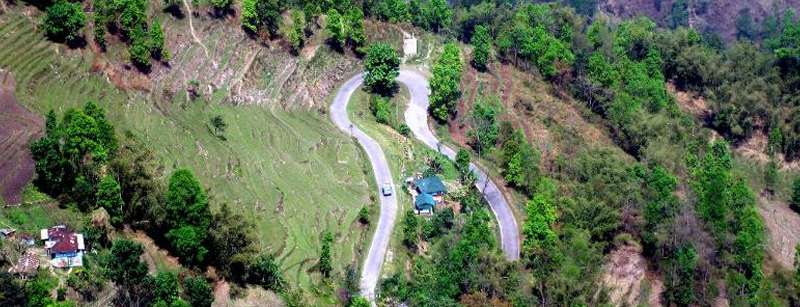
Pedong at an altitude of 4100 ft is becoming one of the most favoured tourism destinations in Eastern Himalaya. Pedong is only 21km away from Kalimpong, is a historical place with abundant natural beauty and lies on historical silk route. Pine forests, lush green valleys and majestic view of Mt. Kanchenjunga and Mt. Siniolchu make beautification to this place. Almost 200 years ago this place was under the rule of Bhutan. The name of this place certifies that as the name is derived from Bhutanese language. In Bhutanese language ‘Pe’ means Pine and ‘Dong’ means tree thus the land full of pine trees is known as Pedong. Pedong witnessed the long standing feud between Lepchas and Bhutias and the ruins of Damsang Gadi Fort was the centre of it. After Anglo – Bhutanese war in 1865, British took control over Pedong. Around 1700 during the rule of Bhutanese king Sangchhen Dorje Monastery was built now which has become a prime tourist attraction of Pedong. Apart from history Pedong is also very rich in avifauna and is a must visit place for bird watchers. Travellers those who are looking for something new, something different, something authentic then Pedong is the place to be with a very beautiful blend of history, culture and nature.
Rishikhola

Rishikhola also spelt as Reshikhola is a small valley situated on the bank of river Reshi or Rishi just 37 km from Kalimpong at an altitude of 2000 ft. Lies on the historical silk route. Those who dreamt a holiday filled with a bit of laziness, getting away from regular cell calls, busy meeting schedules, nature all around with deep lush green forest everywhere, snowy mountains behind the green carpeted forests, consistent chirps of innumerable birds which you have never heard, slightly noisy hilly river on one side and you are busy exploring fishing Trout’s, it is a time to fulfil your dream. Yes Rishikhola promises you to be your perfect dream fulfilling destination. It is also an ideal spot for romancing the moonlight with a light barbecue and bonfire. Tourists can also indulge in luxury of bathing in the crystal clear river water. Tourists can also get a feel of staying in pitched tents and test their wilderness streak. For trekker and adventure seeker Reshi offers innumerable opportunities for them to rock climbing and short treks. Rishikhola provides ideal atmosphere to resident and migratory birds in the Himalayan region, an ideal paradise for bird watchers. Listening to the soothing sound of the flowing river while enjoying fresh cool breeze Rishikhola is an ideal place to enjoy the wonders of nature and to rejuvenate yourself or spend the quality time with your beloved ones amidst the nature.
Ramdhura
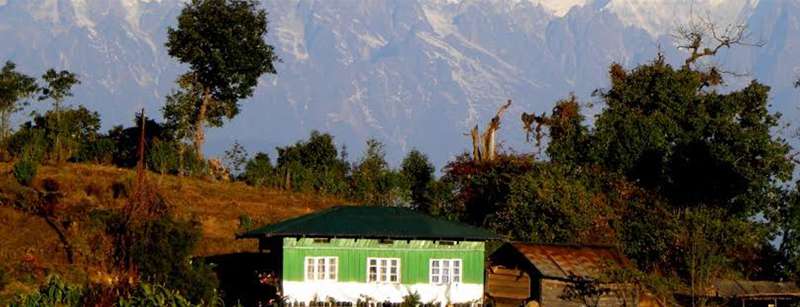
15 km from Kalimpong a small quite village is situated with majestic view of Eastern Himalayan range is Ramdhura. From Ramdhura exotic view of Mt. Kanchenjunga, the Teesta River, the pine forests, the Cinchona Plantation and the lofty mountains are breathtaking. The name Ramdhura is a combination of Ram (of Ramayana) and Dhura, which means village. The village is situated at a great height, above a dense forest of pine and other hilly trees and offers absolute tranquillity. Being a small, underdeveloped village, which has caught the limelight very recently, Ramdhura cannot provide you with luxurious accommodation options, but once you reach the place, perhaps those luxuries will not mean much to you, since Ramdhura will delight you with its natural treasures by that time. As for accommodation home stays are available in Ramdhura. To overcome the heat of the plains, in the summer and to escape from urban cacophony for a day or two Ramdhura is ideal destination. Ramdhura is ideal for short trekking or mountaineering trips. It also houses the British-built Jalsa Bungalow, constructed in 1930. This beautiful bungalow is another attraction of Ramdhura. From here visit nearby Mahadev Dham temple. Don’t miss Hanuman Tok which is a viewpoint in Ramdhura with spectacular view of valleys and mountains. Ramdhura nestled almost in the centre from where few more destinations can be reached including Deolo Nature Park, Rikisum, Algarah Bazaar, Sillery Gaon, Icchey Gaon, Lava, Pedong, Lolegaon, Kalimpong and Rishyap. Sightseeing in Icchey Gaon and Sillery can be a memorable experience. Ramdhura is the new found gem of North Bengal surrounded by pine forests caressed by clouds and the view of flickering lights of Kalimpong in the night, makes it an ideal weekend destination.
Ichhey Gaon
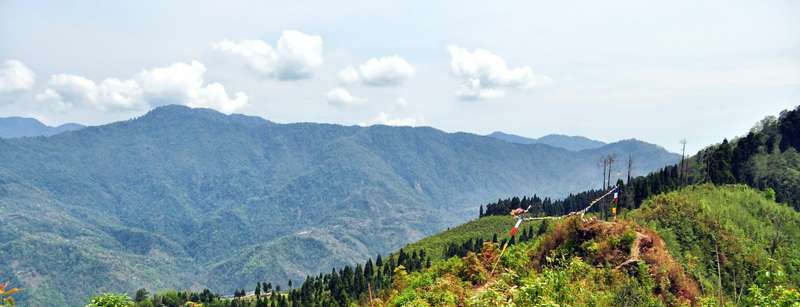
In Sherpa language ‘Itse’ (pronounce ‘iishey’) means “top of the hill” and ‘Gaon’ stands for village. That means a village on hill top. But tourist from Bengal started pronouncing it Icchey Gaon, which means in Bengali ‘Wish Village’. But both the name and its meaning are very much appropriate for this sleepy little village. The village situated at the top of a hill at an altitude of 5800ft and the wish of travellers will be fulfilled in every manner. Wish of staying in quite nature, wish to enjoy majestic views of snow-capped Eastern Himalayas, wish to take some short walk amidst nature and wish to stay in a homely atmosphere with tasty foods all will be fulfilled once traveller reach here. Icchey Gaon situated only 17 km away from Kalimpong with a panoramic view of Mt. Kanchenjunga is a perfect place for those nursing the soul of a nature lover. With numerous nature trails and short treks starting from this place to viewpoints like Ramitey Dnara, Tinchuley and Jalsa, it is one of the best-kept secrets of this region. The evenings at Icchey Gaon become very exciting when lights of Darjeeling, Ravangla and Namchi twinkle all along the slopes of the mighty Himalayas. Host of the home stays will play perfect role by arranging transports for sightseeing or accompanying guest as guide for local sightseeing on foot. No fear, no crowed, no tension, no stress – the place has only happiness to offer its guests. This village is famous for its sensational view of the Kanchenjunga and the canopy of Rhododendron. Witnessing sunrise over Mt. Kanchenjungha from Ramitey Dnara will be a long cherished treasure for travellers. Enjoy the sweet songs of the birds while getting mesmerised with the breathtaking view of Teesta River from almost 6000 ft elevation. Just imagine staying in a wooden cottage in the midst of dense alpine forest with a 360 degree view of the Himalayas.
Sillery Gaon

At an altitude of 6000 ft and at a distance of 23 km from Kalimpong Sillery Gaon is a small hamlet residing on the Himalayan mountain range very close to Pedong. Sillery Gaon is being hailed as the New Darjeeling by the locals, due to some similar features. Shrouded amidst tall pine trees, this place offers majestic views of silver shimmering Kanchenjunga. During British era this village was emerged due to cinchona plantation. 30 families used to leave here and all of them used to make their earning from plantation work. ‘Sillery Shag’ (an edible vegetable) was predominately cultivated in this village thus the village was christened as ‘Sillery Gaon’. Sillery Gaon is where silence and peace is in abundance along with the sheer natural beauty for those urban dwellers who wants a break from their hectic city life. Apart from the serene ambiance there are many places nearby worth visiting such as Ramitey Dnara at a walking distance of 35minutes, Tinchuley view point which provides an awesome view of mountains and valleys, Damsang Fort of last Lepcha king at 45 minutes trekking distance. This is the only fort in the whole of Kalimpong district. A 13th century old Gompa (monastery) near the Mahar regiment base at Pedong with mummies of spiritual leaders is a place worth visiting. Sillery Gaon would make your visit an invigorating one, hence you can visit here anytime of the year. Sillery Gaon is blessed with lush greenery and provides a spectacular view of Kanchenjunga, the third highest mountain in the world making it an ideal get away from your hectic life.
Lava

Lava a sleepy little hamlet located at the fringe of Neora Valley National Park situated at an altitude of 7,218 ft and its distance from Darjeeling is 80 km, from Siliguri is 102 km. This small settlement is situated 34 kilometres east of Kalimpong via Algarah in Kalimpong district. Lava surrounded by virid woods is one of the few places in West Bengal where winters are snowy. The route to Lava is scenic with the change in vegetation from tropical deciduous to the wet alpine trees of fir, pine and birch. Because of its location Lava has become the paradise for the bird’s watchers. There are few birding treks around Lava such as Rachet Reserve Forest trek, Rangbang Valley trek, Upper Rishi Valley trek and Neora Valley trek. Among the birds those can be spotted are Hill Partridge, Kalej Pheasant, Darjeeling Woodpecker, Great Barbet, Golden Throated Barbet, Drongo Cuckoo, Tawny Owl, Eurasian Sparrow hawk, Black Eagle, Common Kestrel, Common Green Magpie, Grey Tree pie etc. There is a Nature interpretation centre in Lava where one can learn about the flora and fauna of Neora Valley National Park and get a briefing about the type of plants and animal found in there. One of the most tranquil places to visit in Lava is Lava Monastery. Close to the local market (bazaar) is Lava Jamgyong Kongtrul Monastery with a serene and peaceful ambience not only calm your mind also offers breathtaking view of snow-capped mountains.
Kolakham

Kolakham is a small village in Kolbong Forest within the Neora Valley National Park is 32 km from Kalimpong town. Kolakham is an ideal destination adventure and peace at the same time. Situated at an altitude of 6100 ft Kolakham is a village to experience wilderness from a close distance. The scenic beauty of the road is real visual pleasure as the road is curved through the dense and lush green tropical and alpine trees. Located almost within the fringe of Neora Valley National Park wildlife can be spotted in abundance during stay in Kolakham. The green forest, majestic white topped Himalayas and variety of birds are the real treasure of Kolakham. On a clear day the majestic view of Kanchenjunga on first sunlight can be a real mesmerising experience of a lifetime. Kolakham can be the base station for some thrilling trekking routes through Neora forest as well as towards Sikkim. Though it is a very small village yet Kolakham offers an array of activities like hiking, trekking and rope traversing making it an ideal destination for the entire adventure seeker or for the people who wants to experience this entire thing once in a life time. If you are interested in star gazing then once again Kolakham is the right choice for you.
Lolegaon
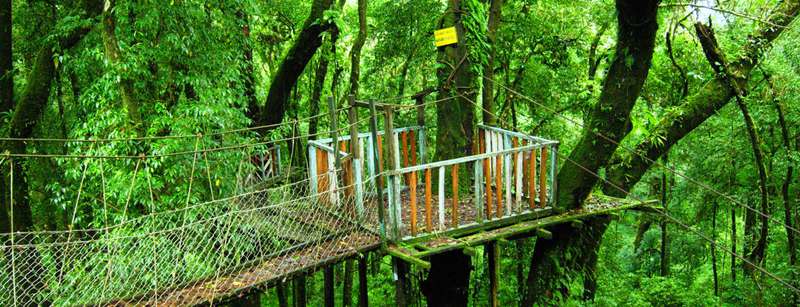
Lolegaon a tiny little Lepcha village situated on the far end of Himalayan ridge in Kalimpong district is located at an elevation of 5,495 ft. The distance of Lolegaon from Darjeeling is 80 km, from Siliguri 98 km, from Kalimpong 31km and from Lava it is 24 km. Lolegaon shrouded amidst alpine forest is famous for its panoramic view of Mt Kanchenjunga and is a treat for the eyes of the nature lovers. Lolegaon is the place for exquisite wilderness and tranquillity. The place to explore during Lolegaon visit is the famous Canopy Walk. It is a180 meters long hanging wooden bridge on tree top that goes through the dense jungle. The bridge slowly rises in height and you will find yourself walking through the tree tops amidst dense forest, making you feel ecstatic and a part of nature. If you want to be adventurous you can further explore the forest area. Just take a 10 minutes’ walk through the pine, cypress and oaks standing high with their mossy trunk is an ideal place for watching endangered Himalayan species like black bear and mountain goats, numerous colourful birds and butterflies and rare orchids. Lolegaon is the place to feel the exquisite wealth that nature has showered. Sunrise over the Kanchenjungha is another astounding view that Lolegaon offers its guests.
Charkhol
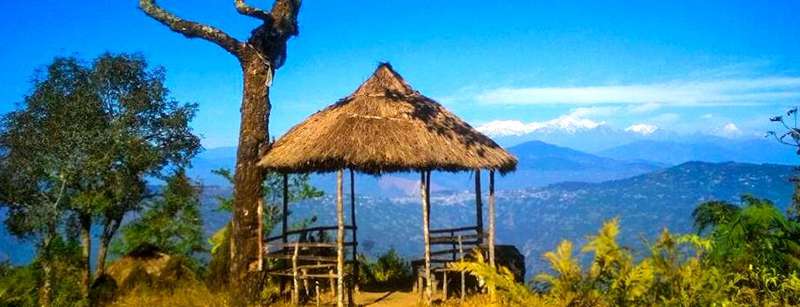
At an approximate altitude of 5000 ft a sleepy little lone land is situated amidst on the top of a hill in the lap of the Himalayas is Charkhol. From Lolegaon Charkhol is a 45 minutes drive to cover 12 km, from Lava it takes one hour thirty minutes while it is 43 km from Kalimpong. The small Lepcha village of Charkhol also spelled Charkhole is indeed heaven on earth with all natural surroundings. Charkhol offers an mysterious warmth with honest hospitality, deep moist forest of huge Pine, Cypress, Oak, Shal and Rhododendrons with the widest possible view of the snow capped view of mighty Kanchenjunga,. The chirps of these beautiful birds along with some very rare species of Butterflies all around will definitely charm you in Charkhol. Apart from experiencing memorable sunrise over Kanchenjungha the night view of Kalimpong towns light is spectacular. Tourists witnessed this beauty named this night lighting of Kalimpong as ‘Queens Necklace’. From Charkhol there are quite interesting trek routes available such as to Kafer (Lolegaon), Lava, Rishyap, Samtahar, Pedong, Rikisum, Rishi, Gumba Dnara and Chukhim. Taking a stroll in the nearby places, bonfire under the starry night, the Milky Way splashed across the sky is an incredible sight, and amateur and professional photographers alike love to capture scenes of the night sky that only a light-pollution-free area can offer.
Jhandi

Situated at an elevation of 6800ft, Jhandi is the perfect destination during summer season to escape the scorching summer heat of plains. The route leading towards Jhandi is filled with pictorial view of lofty mountains, lush tea garden and dense forest. Route to Jhandi is known for being the most pictorial route of the region. Jhandi is the only place in West Bengal Where one can see Mt Kanchenjunga and Teesta basin standing on the same spot. While travelling towards Jhandi via Gorubathan a stopover on the bank of Chel for few moments would be enthralling. Surrounded by dense evergreen forest of Sal and Pine trees Jhandi offers tourist few destination to visit with the most astounding scenery of adjacent valley and Himalayan Range. The Sunrise and Sunset Point commonly known as Jhandi Dnara is one of the most famous tourist attractions of Jhandi. The phenomenal view of the sunlight slowly making its way over the mountains, and filtering through the mist, definitely is a moment worth capturing in Jhandi. Watching the surreal sunrise over snow capped Mountains while listening to the soft chirping of the birds from Jhandi Viewpoint has become a famous tourist activity. From Jhandi a trip towards Lava can be taken. On the way to Lava there is an organic tea garden worth visiting is Samabeong tea garden. A trip to Samsing, Sunthalekhola and rocky Island also can be taken through en route Sakhyam Khola and Mal forest.
Quick Enquiry
Got a question ?
Don't hesitate to call or mail us. Our team experts will be happy to answer your queries
: +91 12345687960
: help@darjeelingholidays.com


